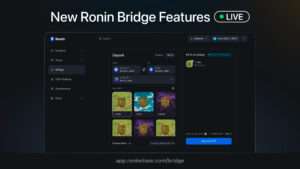Latest News
- Binance Dubai to Delist Privacy Coins and Non-AED Fiat in Regulatory Compliance Push
- Polygon PoS Thrives In Web3 Gaming With 10M+ Players And 222M Transactions
- Advice for investing on a budget
- Crypto Price Analysis 1-31: BITCOIN: BTC, ETHEREUM: ETH, SOLANA: SOL, RIPPLE: XRP, UNISWAP: UNI, COSMOS: ATOM, RONIN: RON
Current Price
The current price of RON is $0.49264
Introduction
Ronin (RON) has emerged as a pivotal player in the blockchain gaming landscape, initially tailored for the popular game Axie Infinity.
Its innovative sidechain architecture promises enhanced transaction speeds and reduced costs, which are critical factors for gamers and developers alike.
As we explore its key features, use cases, and how it stacks up against other cryptocurrencies, a closer examination reveals not only its potential but also the challenges it faces in a rapidly evolving market.
What lies ahead for Ronin, and how might it shape the future of gaming? Let’s find out…
Quick Overview
- Ronin (RON) is a blockchain project designed primarily for enhancing gaming experiences through a dedicated sidechain for faster transactions.
- It employs Proof of Authority consensus, ensuring high transaction speeds, security, and scalability for a growing user base.
- RON tokens are used for governance, staking, and transaction fees, empowering players with true ownership of in-game assets.
- The platform boasts low transaction fees and high throughput, making it economically viable for developers and enjoyable for players.
- Ronin prioritizes security with multi-signature wallets, regular audits, and a decentralized governance model to foster community participation.

Overview of Ronin (RON)
Ronin (RON) is a blockchain-based project designed to enhance the gaming experience through its unique ecosystem. Developed initially to support the popular game Axie Infinity, Ronin aims to address the limitations of existing blockchain networks, particularly regarding speed and transaction costs. By utilizing a dedicated sidechain, Ronin facilitates faster and cheaper transactions, enabling seamless gameplay and improved user engagement.
The project emerged from the need for a more scalable solution for decentralized gaming. Traditional blockchains often face congestion and high fees, which can hinder the overall gaming experience. In response, Ronin employs a Proof of Authority consensus mechanism, allowing for greater efficiency and reduced latency. This approach not only fosters a vibrant gaming environment but also encourages developers to create and deploy their own games on the platform.
Furthermore, Ronin incorporates its native token, RON, which serves multiple purposes within the ecosystem, including governance, staking, and transaction fees. This integration of a dedicated cryptocurrency enhances user participation and investment in the ecosystem.
Key Features of Ronin
Ronin (RON) presents several key features that enhance its overall functionality and user experience.
Its scalability and performance capabilities are designed to accommodate a growing number of users and transactions efficiently.
Additionally, the platform emphasizes security measures and boasts a user-friendly interface that facilitates ease of navigation for both novice and experienced users.
Scalability and Performance
Scalability and performance are vital factors that determine the effectiveness of any blockchain platform, especially in the context of gaming and decentralized applications. Ronin, designed specifically to enhance the user experience for games like Axie Infinity, addresses these concerns by implementing a sidechain architecture. This reduces congestion on the Ethereum mainnet, allowing for faster transactions and a more seamless gaming experience.
The Ronin network supports high throughput, boasting the capability to process thousands of transactions per second. This is essential for gaming applications where microtransactions are frequent and delays can hinder gameplay. By minimizing latency, Ronin empowers users to engage in real-time interactions without the frustration of slow confirmation times.
Additionally, Ronin’s use of a delegated proof-of-stake consensus mechanism allows for efficient block validation, enhancing overall network performance. This design not only improves transaction speeds but also reduces the cost of operations, making it economically viable for developers to create and maintain decentralized applications.
Security Features Overview
Ensuring robust security is paramount for any blockchain platform, particularly in a landscape where digital assets and user trust are at stake. Ronin, designed specifically for the Axie Infinity ecosystem, incorporates several security features that address potential vulnerabilities inherent in decentralized finance (DeFi) environments.
One of the key elements of Ronin’s security framework is its use of a Proof of Authority (PoA) consensus mechanism. This mechanism not only enhances transaction speed but also minimizes the risk of malicious attacks by limiting the number of validators to trusted entities.
Additionally, Ronin employs multi-signature wallets, which require multiple approvals for transactions, adding an extra layer of protection against unauthorized access and theft.
Furthermore, the platform utilizes regular audits and continuous monitoring to identify and rectify vulnerabilities proactively. Ronin aims to maintain high standards of security through collaborations with reputable security firms.

User-Friendly Interface Design
A user-friendly interface is critical for enhancing the overall experience within blockchain platforms, particularly for those engaging with decentralized applications. Ronin (RON) stands out in this regard by prioritizing simplicity and accessibility in its design. The platform adopts an intuitive layout that minimizes the complexities often associated with blockchain technology, ensuring that users, regardless of their technical expertise, can navigate seamlessly.
Key features of Ronin’s interface include a streamlined dashboard that provides quick access to essential functions such as wallet management, transaction history, and staking options. Visual elements are thoughtfully integrated, with clear icons and organized menus that facilitate a smooth user journey.
Additionally, the platform employs responsive design principles, allowing users to interact effortlessly across devices, whether on desktop or mobile. Furthermore, Ronin incorporates educational resources and tooltips within the interface, empowering users to understand the various functions without feeling overwhelmed.
This focus on user experience not only encourages broader adoption of the platform but also fosters a sense of community among users. Overall, Ronin’s user-friendly interface is a significant asset, contributing to its appeal in the competitive landscape of blockchain solutions.
Use Cases in Gaming
The integration of Ronin (RON) into gaming ecosystems has opened up new avenues for player engagement and economic interaction. By facilitating the seamless transfer of in-game assets and currencies, Ronin serves as a bridge between traditional gaming and decentralized finance (DeFi). This integration allows players not only to own their digital assets but also to trade them on secondary markets, enhancing their overall gaming experience.
One of the most prominent use cases is seen in play-to-earn models, where players can earn RON tokens through gameplay. This incentivizes participation and fosters a vibrant economy within the game. Additionally, Ronin’s layer-2 solution considerably reduces transaction fees and speeds up processing times, making microtransactions feasible for in-game purchases and asset trading.
Furthermore, the interoperability of Ronin with various gaming platforms encourages developers to create cross-game functionalities, allowing players to utilize their assets across multiple titles. This interconnectedness is pivotal in shaping a more dynamic gaming landscape, where players are empowered with true ownership and monetization opportunities.
Comparison With Other Cryptocurrencies
When comparing Ronin (RON) to other cryptocurrencies, several key differences and similarities emerge that are critical for understanding its unique position in the market.
Primarily designed as a sidechain for Ethereum, Ronin focuses on enhancing gaming experiences, particularly within the Axie Infinity ecosystem. This specialization contrasts with broader platforms like Ethereum and Binance Smart Chain, which cater to a wide array of decentralized applications (dApps).
In terms of consensus mechanisms, Ronin employs a delegated proof-of-stake (DPoS) model, optimizing transaction speeds and efficiency. This is significantly different from Ethereum’s shift to proof-of-stake, which, while also improving efficiency, encompasses a broader set of use cases.
Additionally, Ronin’s tokenomics, which include lower inflation rates and specific utility tied to gaming, provide unique incentives for users compared to established cryptocurrencies like Bitcoin and Ethereum, which serve as both digital currencies and store-of-value assets.
Transaction Costs and Scalability
Ronin’s focus on gaming applications necessitates a keen examination of its transaction costs and scalability, as these factors directly impact user experience and platform adoption. The Ronin network is designed to facilitate fast and cost-effective transactions, which are vital for maintaining an engaging gaming environment. By minimizing transaction costs and maximizing scalability, Ronin aims to attract a broader user base and enhance player retention.
Key considerations regarding transaction costs and scalability include:
- Low Transaction Fees: Ronin’s architecture notably reduces fees compared to traditional Ethereum transactions, making microtransactions feasible for games.
- High Throughput: The platform can handle a large volume of transactions simultaneously, ensuring smooth gameplay without lag.
- User Experience: Lower costs and faster transactions contribute to a more enjoyable gaming experience, encouraging user participation.
- Adoption Rate: Competitive transaction economics can drive higher adoption rates among developers and players alike.
- Future Expansion: The scalability of Ronin will be essential as more games and applications are built on the network, necessitating ongoing improvements to infrastructure.
Security and Governance
The security of the Ronin network is underpinned by robust smart contract security measures designed to mitigate vulnerabilities and safeguard user assets.
Additionally, its decentralized governance mechanism empowers stakeholders to participate in decision-making processes, fostering a community-driven approach to network management.
Together, these elements aim to enhance the overall integrity and resilience of the Ronin ecosystem.
Smart Contract Security Measures
Ensuring the integrity of smart contracts is paramount in the domain of decentralized finance, necessitating robust security measures and vigilant governance frameworks. The Ronin Network employs a variety of strategies to safeguard its smart contracts against potential vulnerabilities, thereby fostering trust among its users.
Key security measures implemented by Ronin include:
- Code Audits: Regular third-party audits are conducted to identify and rectify vulnerabilities in smart contracts before deployment.
- Bug Bounty Programs: Incentives are offered to ethical hackers for discovering and reporting security issues, promoting proactive identification of flaws.
- Multi-Signature Wallets: Implementing multi-signature wallets enhances security by requiring multiple approvals for transactions, reducing the risk of unauthorized access.
- Automated Testing: Rigorous automated testing is employed to simulate various scenarios, ensuring that contracts behave as intended under diverse conditions.
- Upgradeability: The ability to upgrade smart contracts allows for the rectification of identified vulnerabilities without disrupting overall network functionality.
These measures collectively contribute to a secure environment for users, minimizing risks associated with smart contracts while promoting a resilient framework for decentralized applications on the Ronin Network.
Decentralized Governance Mechanism
A thorough security framework is complemented by an equally robust governance structure within the Ronin Network. This decentralized governance mechanism empowers RON token holders to participate in important decision-making processes, thereby promoting transparency and community involvement.
At the core of Ronin’s governance is a voting system that allows stakeholders to propose and vote on critical changes within the ecosystem, including protocol upgrades and fund allocations. This participatory approach not only enhances collective ownership but also mitigates risks associated with centralization.
By distributing governance power among a diverse group of stakeholders, Ronin aims to create a resilient network that can adapt to evolving market conditions and user needs.
Additionally, the governance model incorporates checks and balances to prevent potential abuses of power. For instance, proposals must receive a minimum threshold of support to move forward, ensuring that decisions reflect the consensus of the community rather than the interests of a select few.
This structure fosters a sense of accountability and encourages active participation from all stakeholders, ultimately contributing to the long-term sustainability and success of the Ronin Network. Such mechanisms are essential in establishing trust and facilitating a secure environment for users.
Future Prospects and Developments
As the blockchain landscape continues to evolve, Ronin (RON) is poised to capitalize on emerging trends and technologies that could enhance its utility and adoption. The platform’s focus on gaming and decentralized finance (DeFi) positions it strategically within the growing sectors of the blockchain ecosystem.
Several prospective developments may greatly impact Ronin’s trajectory:
- Integration with New Games: Expanding partnerships with game developers can increase user engagement and token utility.
- Layer-2 Solutions: Implementing Layer-2 scaling solutions can enhance transaction speeds and reduce fees, improving user experience.
- Cross-Chain Compatibility: Developing interoperability with other blockchains can attract a broader user base and facilitate asset transfers.
- Enhanced Security Protocols: Investing in robust security measures will enhance user trust and safeguard assets against potential vulnerabilities.
- Ecosystem Expansion: Introducing new DeFi products and services can diversify the platform’s offerings and encourage more users to participate.
Frequently Asked Questions
What Is the Origin of the Ronin Network?
The Ronin Network originated as a blockchain solution designed to enhance scalability and reduce transaction costs for gaming applications, particularly those associated with the Axie Infinity ecosystem, enabling seamless integration between digital assets and gameplay experiences.
Who Are the Founders of Ronin (Ron)?
The Ronin network was co-founded by Trung Nguyen, co-founder of Axie Infinity, along with other key team members from Sky Mavis. Their collective expertise in blockchain technology and gaming has greatly shaped the platform’s development.
How Can I Store My RON Tokens Securely?
To store your tokens securely, utilize hardware wallets for offline storage, ensuring private keys remain inaccessible to online threats. Additionally, consider multi-signature wallets for enhanced security and regular backups to safeguard against data loss.
What Exchanges Support RON Trading?
Several exchanges facilitate trading for Ronin tokens, including well-known platforms such as Binance, KuCoin, and Huobi. Traders should evaluate each exchange’s security measures, fees, and liquidity before engaging in transactions to guarantee ideal trading conditions.
Are There Any Community Initiatives for Ronin (Ron)?
Community initiatives for various blockchain projects often include educational programs, developer grants, and grassroots marketing efforts. Engagement through social media, forums, and events fosters collaboration and innovation, enhancing the ecosystem’s growth and user participation markedly.
Wrapping Up
Ronin (RON) represents a significant advancement in blockchain technology tailored for the gaming industry.
Its unique sidechain architecture facilitates efficient transactions while ensuring low costs, thereby enhancing user experience and engagement.
By prioritizing security, decentralized governance, and true ownership of in-game assets, Ronin fosters a vibrant ecosystem for both developers and players.
Future developments are likely to further solidify its position within the gaming sector, making it a remarkable contender in the evolving landscape of blockchain applications.

